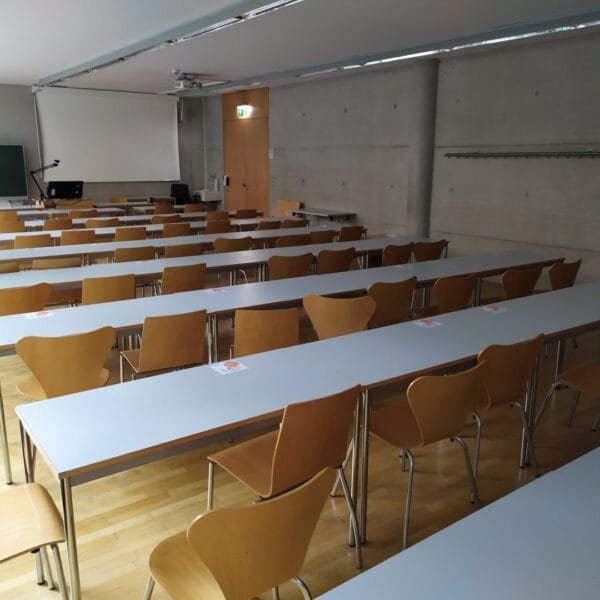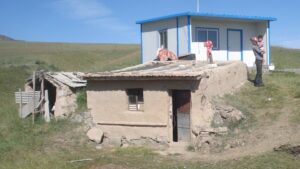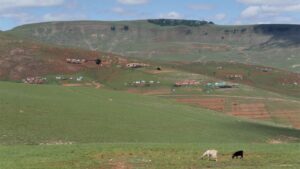ID14: Communicating mountain research otherwise
Details
Full Title
Communicating mountain research otherwise: possible bridges between arts, sciences and beyond
Scheduled
Monday, 2022-09-12
18:30-20:00Convener
Co-Conveners
Jorge Panchoaga and Felix Dorn
Assigned to Synthesis Workshop
–
Keywords
arts and sciences, mountain stakeholders, knowledge co-production, other languages and formats
Description
An increasing number of scholars, researchers, and practitioners interested in mountain regions has resulted in growing communities and networks that develop works and agendas around diverse mountain issues. However, because of the ‘language’ (format), deciphering contents in many of these works is reserved for people with backgrounds in academia or institutions. We ask how and in what format the knowledge and contents produced around mountains are shared with other stakeholders outside academia. This session is a call to show experiences in ‘other ways’, including formats such as image, video, sounds and other possible plastic creations to communicate mountain interests from the diversity of stakeholders that participate in the (co)production of meaning, knowledge and research. We explicitly invite innovative and creative works that use and show other forms and formats. The aim of this session is to challenge the dichotomy between arts and science, attempting to build bridges between scientific and other forms of knowledge production and its communication.
Important hint:
After the session, the documentary film “Arreo – A Story of Transhumant Gauchos” (Tato Moreno; Arg.; 2015; orig. Spanish with English Subtitles) will be shown in the same room, followed by a Q&A session with the director.
Registered Abstracts
Abstract ID 203 | Date: Scheduled by Convener | Type: Oral Presentation | Place: SOWI – Seminar room U3
Kister, Jutta (1,3); Ossner, Roman (2); Segat, David (1); Balling, Jessica (3); Stannarz, Marc (2)
1: University of Innsbruck, Austria
2: Sektion München, Deutscher Alpenverein e.V., Germany
3: Katholische Universität Eichstätt-Ingolstadt, Germany
Keywords: Science Communication, Sustainability Mountain Research, Transdisciplinarity, Role-Playing Game, Climbing
Approaching issues of sustainable development processes requires the capability to understand problems within their complexity of contexts and interrelatedness. Research subjects are entangled in human-environment relations, various interests and perspectives. Natural conditions play a role as well as cultural, political and historical aspects.
Based on a research project on the sustainable operation of high mountain huts, we developed an indicator-based monitoring tool to evaluate the status of a broad range of sustainability aspects. The knowledge was gained in co-production of scientific partners and practitioners. The aim is to broaden the view from sectoral approaches to a more integrative approach including ecological, economic and social pillars of sustainability. This includes but is not limited to emissions, environmental protection as well as flows of food supply and disposal and the mobility linked to mountain sports trips. As many of the aims of the sustainability process include the behaviour of the hut´s guests respectively mountaineers and trekkers, we decided to develop a communication format that functions as a game for a broad range of ages. The format of a role-playing game (RPG) enables to include different points of views and fosters understanding of various constraints and objectives of stakeholders in the mountains, e.g. hut tenants, mountaineers, food suppliers. The RPG is played in groups and uses a climbing wall. The knowledge transfer to society is realized through active, creative gaming and corporeal endeavours that support to open up to new ways of thinking (based on the idea of learning while moving).
The game can be played in climbing halls on the huts, in natural climbing sites in the hut’s surrounding as well as in the increased number of indoor climbing halls. It can easily be played in youth climbing groups or mountaineering courses to implement a sustainability learning issue.
Abstract ID 228 | Date: Scheduled by Convener | Type: Oral Presentation | Place: SOWI – Seminar room U3
Hubatschek, Irmtraud
Edition Hubatschek, Austria
Keywords: Photography, Visual Arts, Thematic Trail, Women’s Work, Oral History
This was the despairing cry of the French sociologist A. Asselin and she tackled the problem by making documentary films about her topics of research – thereby opening up completely new horizons for communicating her issues.
In the late 1930’s, the Austrian geographer and anthropologist Erika Hubatschek (1917-2010) was not satisfied with the existing photographs in her field of research. So she took her own photographs – which today are all historic documents – for a strictly scientific purpose as illustrations of her geographical and anthropological research into the making of the alpine landscape and the life and work of mountain farmers. Much later, Erika realized the extent to which her 14 000 negatives were a mirror of a time bygone, and she started to exhibit them throughout Europe and the US. In her later years, she was considered as much as a “photographer” as a scientist and her work was also widely recognized for its artistic value, leading to many international exhibitions, even in the Leica Gallery in New York. Her photographic work from 1939 to 1962 is particularly interesting on account of the wide range of topics it covers: from rural history to agro-sociology, from architecture to anthropology, from gender studies to ecology.
How can we today deepen the impact of scientific research by linking it to forms of communication based on artistic expression?
I am now presenting Erika’s main topic, LIFE ON THE STEEP SLOPE, in various different ways:
- Exhibits of photographs and large-size canvas prints
- Richly illustrated books
- Thematic trails
- Visual readings
- Documentary films
My own ongoing visual project is Himalay’Alps 1::2::3, a visual bridge over distance and time. It is the comparison between women’s work in mountain areas (Alps/Himalaya) over a period of approx. 80 years: is it “same-same” as they say in India, or what differences in tools, methods of working, social organisation, climatic influences and changes can be observed?
We have never before had so many different tools for arts-based scientific communication at our disposal: from classical formats like photographs and slides to video, films, blogs and installations – with all of these we can come closer to the public and allow people to discover new aspects of scientific research.
Abstract ID 800 | Date: Scheduled by Convener | Type: Oral Presentation | Place: SOWI – Seminar room U3
Weisleitner, Klemens (1); Sattler, Birgit (1); Scheide, Günter (2)
1: University of Innsbruck, Institute of Ecology, Austrian Polar Research Institute, 6020 Innsbruck, Austria
2: University of Innsbruck, Transferstelle Wissenschaft – Wirtschaft – Gesellschaft, 6020 Innsbruck, Austria
Keywords: Ice, Vulnerable Habitats, Emotions, Photographs, Science Communication
Nowadays, it is general knowledge that the Earth is losing its ice masses. It is a highly regarded research topic, humanistically strongly mystified, diverse in appearances, and aesthetically irrefutable. By communicating ice via emotions this way of scientific knowledge – depicted by photographs – it is intended to represent the intersection of all these perceptions. Over several years of research expeditions, various facets of ice have been collected to transport the vulnerability and dynamics of ice as water storage, bizarre sculpture, or living space to the laypeople. Research and fascination about this frozen world from the millimeter range to far-reaching landscapes were captured from the Alps, the Arctic, and Antarctica. The fragility of sensitive living habitats can be delivered to the general public with the help of professional communicators to make science accessible by emotions.
Abstract ID 828 | Date: Scheduled by Convener | Type: Oral Presentation | Place: SOWI – Seminar room U3
Silva, Júlio; Baptista, Cecília; Santos, Luis; Figueira, Luis Mota
Institut Polytechnique de Tomar, Portugal – Techn&Art Center
Keywords: Documentary, Didactic, Karst Mountains, Communication
This project derived from the long term needs to preserve the mountain´s cultural heritage through the involvement of people and organizations. The livelihoods of mountain people hold a singular richness associated with the harsh and simultaneously breath-taking scenery. The specific objective of this project is to generate scientific communication based on Natural and Cultural Science through pedagogic and didactic methods.
The project is developed at 4 levels corresponding to 4 different target publics. The levels are Basics, Dissemination, Advanced knowledge and Research with corresponding activities. This multimedia production documentary presents and explores scientifically both mountains in their diversity: water, vegetation, geology, arts and crafts, traditional local and contemporary culture.
The transdisciplinary team visited the territory in search of a true thorough record of these mountains. Some of the geologic places visited comprised several characteristics of this Karstic region. The natural, cultural and built monuments, are didactic elements to explain the natural cycles and their transformation into artworks. In this context, an observation of artistic productions amplifies the participant´s experience in the programmed actions. After this stage, researchers approached locals, as they are the harder public, to test the different versions, thus observing and recording their reactions.
Based on the final product the team explores manners of presenting the same content to various target audiences and age groups from children to the elderly, or tourists to scientists. The final product displays images from the making to the testing as a scientific record for posterity.
The expected results are to disseminate knowledge and incentive the participants to create value, qualifying people, organizations and territories.
Abstract ID 851 | Date: Scheduled by Convener | Type: Oral Presentation | Place: SOWI – Seminar room U3
Roztočil, Tomáš
Palacký University Olomouc, Czech Republic
Keywords: Affect, Human Geography, Field Recording, Non-Representational Theory, Inderdisciplinarity
Mountains have always been a major object of human fascination as well as source of inspiration. Role of the mountains in myths, literature and other cultural narratives is complex, and ever-changing. From prehistory, when high places were seen as abodes of gods, via patriarchal narratives of heroism and conquer, we have come all the way to polished Instagram visions or rigorous datasets of what becomes an emptied simulacrum of once sacred wilderness.
Communication concerning mountains should always be impactful and contribute to their future preservation. Theoretical research, however, often feels detached from the affective reality of the mountains themselves, coding the complex realities of the mountains either into isolated datasets and numbers wrapped in complex terminologies, or into abstract musings of spatially-oriented philosophers.
Hence, the project Mountain Revisited strives to marry theoretical, artistic and individual experience of the mountains through interdisciplinary, affect-oriented research methods that enable students, and general public to understand the mountain space from new perspectives. Revisiting our concept of mountains through fresh pathways could offer deeper insights to what mountains mean to us beyond mere analytical thought – only through practice theories come alive and make a real impact.
The plen-air follows a year-long project, which travels through gaps between theory and practice, research and art, humanities and science. The session will offer research methods based on working with affects, various media including field recording, working with sound, and personal narratives and performances. The methods shared at the plen-air session were implemented and tested during classes with students and in fieldtrips beyond walls of the academia.
The workshop will start with a coverage of affect-related theories and methodologies of the mountains and venture towards examples and experiments from the research and didactic practice, that can be easily implemented in the later practice of the members of the audience. The presentation will highlight the importance of fieldwork and being in the mountain space itself, moving to a final sonic immersion (field recording performance) that will transport the audience into the soundscape of the mountains near and far.
Fusion of theory and practice shared at the event shall broaden methodological and didactic inventory of the audience, and contribute to better understanding, mediation and consequently sustainability of both cultural and natural mountain spaces for future generations.
Abstract ID 966 | Date: Scheduled by Convener | Type: Oral Presentation | Place: SOWI – Seminar room U3
Moreno, Néstor Edgardo (1); Ruiz Peyré, Fernando (2)
1: 24Pfilm, Argentine Republic
2: Institute for Interdisciplinary Mountain Research, Austrian Academy of Sciences
Keywords: Documentary, Transhumance, Science Communication, Sustainability Mountain Research
This project is motivated by the urgent need to preserve the beauty and sustainability of transhumance. The seasonal droving of livestock along migratory routes to take advantage of the best pastures, has been practiced for more than 7000 years. Far from being a relic of the past, it is a fantastic adaptation to changing climate conditions, and an exceptional way of making sustainable use of the natural resources that we have. While this ancestral practice is disappearing in many regions of the world, some farmers continue resisting in different contexts and conditions. With two feature-length documentaries, ARREO (2015) https://youtu.be/DlI9xZchGZU), and “TRASHUMANTES. Suso & Eliseo” (in final stages of production), we want to go inside the everyday life of two farmers and families in Argentina and Spain, who proudly still live this tradition and fight for its continuity.
Documentaries are powerful systems of representation that could build solid bridges between stories and audiences to convey important issues in a way that audiences could draw their own conclusions, not by imposition but by simple comprehension and empathy. That is possible only if we are profoundly aware of certain mechanisms on how we approach the story, how we relate with characters, how we portray the environment, and how we choose the narrative language.
Finally, we think it is necessary to highlight transhumance high cultural value, as it is an ancient practice that is transmitted orally, from generation to generation. It is not only a mode of production, but a way of life and a culture that makes up a rich, intangible heritage. We believe that the importance of documentaries relies not only on the scientific and cultural values we try to communicate, but on the way we build the narrative. We want to share our experience on the permanent learning process of communicating and creating the most direct bridge between stories and audiences.



